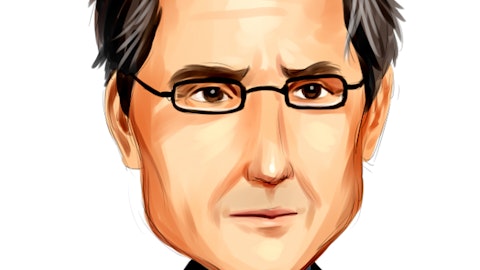Scott Siefers: Okay. Perfect. All right. Thank you very much.
Operator: And our next question today comes from Mike Mayo with Wells Fargo Securities. Please go ahead.
Mike Mayo: Hey, Bill, I’m wondering if the optimization, maybe you could call it Truist 2.0 is going fast and deep enough, and I do recognize two items. One, you’ve mentioned headwinds in the past from rates, regulation, and retooling. And second, your new efforts, the $750 million savings program, 4% less headcount, 4% less branches ahead. But then I look at the core efficiency numbers, I’m like, oh, this is not what we signed up for, right? I mean, slide eight, nine, I think lists your core efficiency at 59% in 2023, and now you’re guiding worse for 2024, and your pre-emerger target was 51%. So are you guys doing enough and doing it fast enough to optimize?
Bill Rogers: Yes, Mike, I think an appropriate challenge is always, we’ve done a lot. So I think I’m really encouraged by the momentum and you can see it really in the third and fourth quarter. And you see that significantly and particularly the expense declines. And we’re committed to what we, you know, what we talked about in September. I think our $750 million plan, I’m really proud of our teammates. I’m proud of our leadership. You know, they really got the sleeves rolled up and got after it. So the intensity that’s in this company right now about being more efficient, I feel is demonstrably better. And being able to apply that over this more simplified organizational structures where we see the benefits. So if you think about, as I’ve made in my comments, I mean sort of that process is complete.
So now this intensity, these efforts, these initiatives, we apply that over a much more simplified business model. And the decisions that leaders are making, I think are just better, stronger decisions, which lead us to a more efficient company long-term.
Mike Mayo: My follow-up on optimization, I’ll give to my colleague, insurance analyst, Elyse Greenspan. Elyse?
Elyse Greenspan: Yes, thanks, Mike, and good morning to everyone. On the insurance side, I know there’s been press reports on the potential monetization and sales process of that asset. So I was just hoping that you can provide, you know, an update to us and just, you know, where you stand with that process?
Bill Rogers: Yes, so I think we’ve said pretty clearly that, the insurance business creates a capital opportunity for us and then like outlined that in a lot of specificity. We’ve said clearly that we’re always evaluating alternatives and we’re going to do the best thing for the insurance business and the best thing for Truist going forward. And I don’t think as it relates to any specific timing and those type of things, I don’t think I really should comment beyond that.
Elyse Greenspan: Okay, thank you.
Bill Rogers: Great, thanks.
Operator: And our next question today comes from Ken Usdin with Jefferies. Please go ahead.
Ken Usdin: Hey, thanks. Good morning. I wanted to ask you to expand a little bit on your outlook for credit. Noticing the NPA decline this quarter and you have an expected charge off normalization path. I’m just wondering what you’re seeing in terms of what areas of the portfolio you’re expecting to see that loss trend higher in the most and just your general sense of just how the customer set feels in terms of, you know, that certainly implies a good ramp from here, but one that’s controllable. So just kind of juxtaposing that NPA decline with your expected ramp and losses? Thanks.
Clarke Starnes: And this is Clarke. Thanks for the question, our ‘24 NCO guidance, as Mike said, it assumes we’re going to continue to see normalization occur, both in consumer and wholesale. We’ve already seen a lot of it in the consumer side. We have a higher mix, as Bill said, of higher margin consumer finance businesses and less relative mortgage and prime auto, that’s a factor on the loss assumption. But I think the biggest one that you’ve pointed out, we’re working really hard to get ahead of any potential areas of stress, think CRE office and so our guidance also reflects opportunities to be opportunistic to work through if we see more challenges in that space as that structural risk unfolds. So we hope to do better, but we’re assuming we’re going to work hard to make sure of that we get ahead of any risk.
Ken Usdin: Thanks, Clarke. And just one follow-up, I’m just wondering, I know you said that you’re expecting a hopeful bounce in the investment banking business. Just wondering where those level of conversations are and just given your mix of business, where we might expect to see that either come back sooner or have a lag relative to the environment? Thanks.
Bill Rogers: Yes, great question. And the good news is we’ve got a really good balanced investment banking business. So, and, you know, seeing some positive things on, you know, a lot of the different buckets. So if you think about equity capital markets, I mean they’re starting to come back. I think we’re starting to see some IPO components of that. Our pipeline there is probably the strongest it’s been in a long time. And pipeline as active book runner. When and if all that comes to bear, I think that’s we’ll just have to, that’ll be a little bit market dependent. On the debt side, sort of the high yield investment grade, I mean, you’ve got a lot of maturity sort of running off in ‘24, so there’s sort of a natural refinance opportunity.
I think, again, sort of that’ll be where clients are projecting where they think rates are going to come. So they’ve got a lot of natural things they have to do and they’ll have to pick that point of demarcation where they want to start the refinancing side. And then the M&A pipeline is really strong. We spent a lot of time in energy with our verticals and being really relevant. So the size and scope of some of the things that we’re doing are proportionally higher, but we’ve also built this really great pipeline with our transition advisory business, with our commercial clients. And we’ve got more in the pipeline there than we closed all of last year, just as an example. So that’s sort of that core bread and butter kind of work. And then we have things that were like public finance, which was sort of a nascent business for us 12, 18 months ago, and now starting to build up some momentum and as we see public finance opportunities starting to grow.





